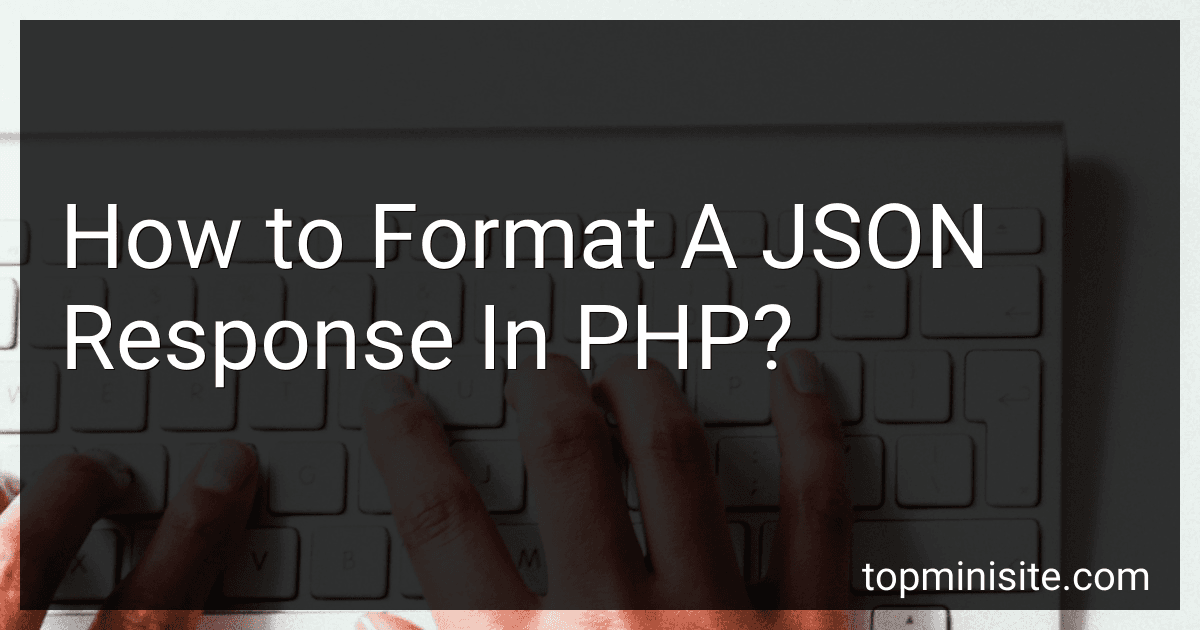To format a JSON response in PHP, you can follow the steps below:
- Create an associative array or an object with the data you want to include in the response. For example:
$responseData = array( 'title' => 'Sample Title', 'message' => 'This is a sample JSON response', 'status' => 'success' );
- Convert the array or object to JSON format using the json_encode() function. This will convert the data into a JSON string. For example:
$jsonResponse = json_encode($responseData);
- Set the response header to specify that the content type is JSON. This helps the client to identify that the response is in JSON format. For example:
header('Content-Type: application/json');
- Optionally, you may need to handle cross-origin resource sharing (CORS) if your response is accessed by a different domain. You can set the necessary headers for CORS. For example:
header('Access-Control-Allow-Origin: *'); header('Access-Control-Allow-Methods: GET, POST');
- Finally, echo or print the JSON response to send it back to the client. For example:
echo $jsonResponse;
By following these steps, you can format a JSON response in PHP. This is commonly used when developing APIs or when exchanging data in JSON format between a server and a client application.
What is the purpose of JSON decode options in PHP?
The purpose of JSON decode options in PHP is to provide additional control and customization when decoding JSON strings into PHP data types.
By default, the json_decode() function in PHP converts a JSON string into a stdClass object or an associative array, depending on the "assoc" option. However, the JSON decode options allow developers to modify this behavior to suit their specific requirements.
Here are some commonly used JSON decode options in PHP:
- JSON_BIGINT_AS_STRING: Normally, large integers in JSON are converted to floating-point numbers in PHP. Enabling this option ensures that large integers are converted to strings instead.
- JSON_OBJECT_AS_ARRAY: By default, json_decode() returns a stdClass object when decoding JSON. This option converts JSON objects into associative arrays instead.
- JSON_THROW_ON_ERROR: When an error occurs during JSON decoding, PHP throws a JsonException. This option can be enabled to automatically throw an exception instead of returning NULL.
- JSON_PRETTY_PRINT: This option formats the decoded JSON with indentation and line breaks to make it more human-readable. It is useful for debugging and logging purposes.
- JSON_UNESCAPED_UNICODE: By default, non-ASCII characters are escaped in the decoded JSON. Enabling this option preserves these characters as they are, without escaping.
Overall, the JSON decode options provide flexibility and control over how JSON strings are decoded into PHP data structures.
How to handle nested arrays when formatting a JSON response in PHP?
To handle nested arrays when formatting a JSON response in PHP, you can use the json_encode() function to convert your PHP array into JSON format. Here's an example:
$data = array( 'key1' => 'value1', 'key2' => 'value2', 'nestedArray' => array( 'nestedKey1' => 'nestedValue1', 'nestedKey2' => 'nestedValue2' ) );
$jsonResponse = json_encode($data); echo $jsonResponse;
In this example, the nestedArray is a nested array within the main array. The json_encode() function will convert the entire array into a JSON string.
The output will be:
{ "key1": "value1", "key2": "value2", "nestedArray": { "nestedKey1": "nestedValue1", "nestedKey2": "nestedValue2" } }
Note that json_encode() automatically handles the conversion of nested arrays into nested JSON objects.
How to set the content type header as JSON in PHP?
To set the content type header as JSON in PHP, you can use the header() function and set the value of the Content-Type header to application/json. Here's an example:
header('Content-Type: application/json');
You should call this function before sending any output to the browser, typically at the top of your PHP file or at the beginning of your script.
How to pretty print a JSON response in PHP?
To pretty print a JSON response in PHP, you can use the json_encode() function in combination with the JSON_PRETTY_PRINT flag.
Here's an example:
// Assume you have a JSON response stored in a variable called $jsonResponse
// Print the JSON response in a pretty format echo json_encode(json_decode($jsonResponse), JSON_PRETTY_PRINT);
In this example, the json_decode() function is used to decode the JSON response into a PHP array or object. Then, the json_encode() function with the JSON_PRETTY_PRINT flag is used to convert the decoded data back into a nicely formatted JSON string.
By outputting the json_encode() result using echo, you can see the pretty printed JSON response in the output.
